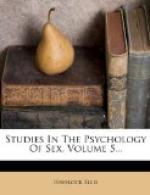A portion of the field of erotic symbolism is covered by what Binet (followed by Lombroso, Krafft-Ebing, and others) has termed “erotic fetichism,” or the tendency whereby sexual attraction is unduly exerted by some special part or peculiarity of the body, or by some inanimate object which has become associated with it. Such erotic symbolism of object cannot, however, be dissociated from the even more important erotic symbolism of process, and the two are so closely bound together that we cannot attain a truly scientific view of them until we regard them broadly as related parts of a common psychic tendency. If, as Groos asserts,[3] a symbol has two chief meanings, one in which it indicates a physical process which stands for a psychic process, and another in which it indicates a part which represents the whole, erotic symbolism of act corresponds to the first of these chief meanings, and erotic symbolism of object to the other.
Although it is not impossible to find some germs of erotic symbolism in animals, in its more pronounced manifestations it is only found in the human species. It could not be otherwise, for such symbolism involves not only the play of fancy and imagination, the idealizing aptitude, but also a certain amount of power of concentrating the attention on a point outside the natural path of instinct and the ability to form new mental constructions around that point. There are, indeed, as we shall see, elementary forms of erotic symbolism which are not uncommonly associated with feeble-mindedness, but even these are still peculiarly human, and in its less crude manifestations erotic symbolism easily lends itself to every degree of human refinement and intelligence.
“It depends primarily upon an increase of the psychological process of representation,” Colin Scott remarks of sexual symbolism generally, “involving greater powers of comparison and analysis as compared with the lower animals. The outer impressions come to be clearly distinguished as such, but at the same time are often treated as symbols of inner experiences, and a meaning read into them which they would not otherwise possess. Symbolism or fetichism is, indeed, just the capacity to see meaning, to emphasize something for the sake of other things which do not appear. In brain terms it indicates an activity of the higher centers, a sort of side-tracking or long-circuiting of the primitive energy; ... Rosetti’s poem, ‘The Woodspurge,’ gives a concrete example of the formation of such a symbol. Here the otherwise insignificant presentation of the three-cupped woodspurge, representing originally a mere side-current of the stream of consciousness, becomes the intellectual symbol or fetich of the whole psychosis forever after. It seems, indeed, as if the stronger the emotion the more likely will become the formation of an overlying symbolism, which serves to focus and stand in the place of something greater than itself; nowhere at least




